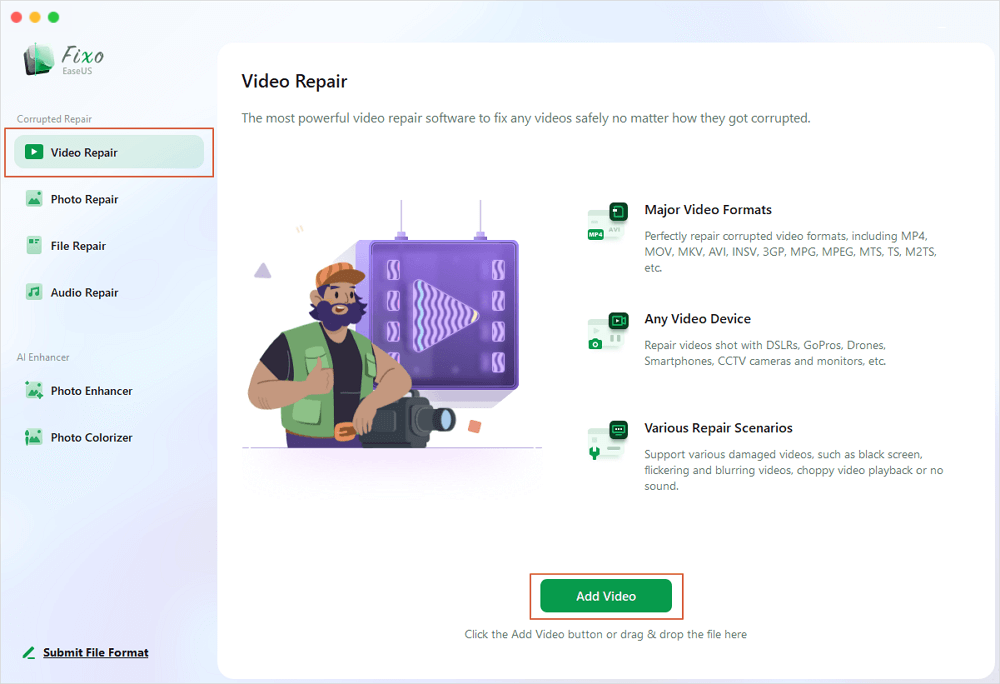How to Use FFmpeg on Mac | Repair with FFmpeg
Jaden updated on Nov 28, 2024 to Files Repair & Photo Restoration Guides | How-to Articles
FFmpeg is an open-source command-line utility for processing audio and video files. However, FFmpeg's ability to fix corrupted videos may be challenging for novice users. This post will show you how to use FFmpeg on Mac.
FFmpeg is a free, open-source software project with many libraries and tools for processing video, audio, and other multimedia files and streams. Video scaling, rudimentary editing (trimming and concatenation), format video conversion, and post-production effects are among its common uses.

With FFmpeg, you can also fix your corrupted video files using different command lines. However, this could be a little difficult. Additionally, the type of problem you wish to solve and the extent of the file damage determines how successful the repair of corrupt video files will be.
Using a specialized video restoration program for video corruption is usually preferable. They can fix corrupted MP4, MOV, AVI, MKV, and all other significant video file formats that are unplayable or display loading errors.
Other apps exist, such as EaseUS Fixo Video Repair, a professional tool for repairing videos.
Step 1. Launch EaseUS Fixo on Mac
Download EaseUS Fixo on your Mac and launch it. Click "Video Repair" on the left and click "Add Video" to upload your corrupted MP4/MOV/MKV/3GP video files.

Step 2. Select the corrupted video and start repair
Select a targeted video and click the "Repair" button to start the single video repairing process. If you want to repair all the videos, select them all and click "Repair All".
Step 3. View and save the fixed videos
Wait a few minutes, and the corrupted videos will be repaired. The time you wait depends on how corrupted your videos are. Then click the "View Repaired" to preview the videos. To save the fixed video, hit the "Save" button. Keeping multiple videos is okay. Just choose "Save All" to complete.
Step 4. Run the advanced video repair process
If the quick repair doesn't work, try the advanced repair mode. Choose "Advanced Repair" to start the process. After uploading an example video, select "Confirm".
Step 5. View and save the video repaired in advance mode
A window of detailed information about the corruption and sample videos will pop up. Click "Repair Now" to start the process. When the repair is complete, you can view the fixed videos and click the "Save" button to keep the repaired video files on the path you want.
If you find this information helpful, please share it with others on social media to help them overcome this common challenge.
You can edit the video you want using FFmpeg on Mac and fix the corrupted video files by opening Terminal on your machine. This command can also solve the moov atom problem from the beginning. It can work with practically any type of file, even enormous ones. Therefore, this program can be used to fix a large video.
First, download the FFmpeg program on macOS. Then try the commands below:
ffmpeg -ss 00:00:05 -i sample.mp4 -to 00:00:10 -c:v copy -c:a copy trim_sample.mp4
ffmpeg -i sample.wmv-c:v libx264 sample.mp4
ffmpeg -i sample.mp4 -vn -ab 128 audio.mp3
Ffmpeg -i original.mp4 -c:a libvoris convert.mkv
After reading this part, you should know how to install FFmpeg on macOS.
If you still have some questions about how to use FFmpeg Mac, check the quick answers below to help yourself out:
1. How do I use FFmpeg?
2. How to Install FFmpeg on Windows?
Installing FFMPEG is not too difficult. Use this link for the gyan.dev download. For a more thorough installation guide, view our blog post with the setup and installation instructions for FFMPeg on Windows.
FFmpeg provides a video repair solution for Windows and Mac systems. Because of its user-friendly interface and simplicity, it can be used by many different types of people to recover erased data.
Related Articles
Can't Open Files on Mac? Fix It With 4 Easy Ways
Fix Some of Your Fonts Cannot Be Saved with the Presentation [Easy!]
Solve Unzip Error: End of Central Directory Signature Not Found
Instagram Video Not Playing But Audio Works on Mac